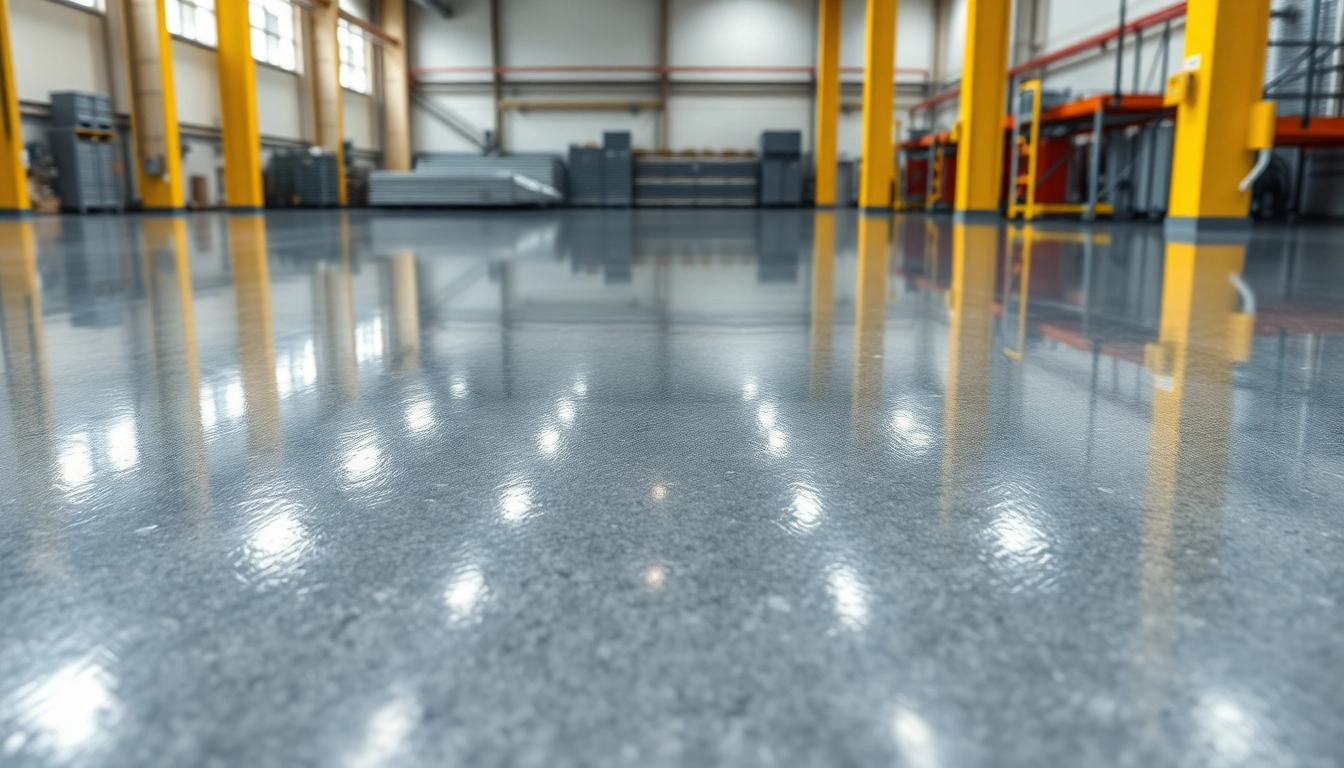Understanding Epoxy Resin Floors: Benefits and Applications
Epoxy resin floors have become a premier choice for both residential and commercial spaces due to their remarkable durability, aesthetic appeal, and versatility. When considering floor coatings that can withstand heavy traffic, chemical exposure, and environmental challenges, epoxy resin floors stand out as a top contender. For those exploring this surface solution, it’s essential to understand how epoxy floors work, their key advantages, and how to select the best system for your specific needs. You can find more comprehensive details about epoxy resin floor options and installation services that align with your project goals.
What is an Epoxy Resin Floor and How It Works
An epoxy resin floor is a composite material formed by applying a resin-based coating onto a concrete or other substrate surface. The epoxy mixture consists of two primary components: the resin and the hardener, which chemically react to form a rigid, rigidified surface. When cured, this layer bonds strongly to the substrate, creating a seamless, high-performance surface.
During application, the epoxy undergoes a chemical transformation known as polymerization, which hardens the coating and provides mechanical strength. This process results in a durable surface resistant to scratches, stains, and impacts. Modern epoxy systems can incorporate decorative pigments, textures, and embedded additives to customize appearance and functionality, making them suitable for a wide variety of environments ranging from garage floors to expansive warehouse facilities.
Key Advantages for Residential and Commercial Spaces
Epoxy resin floors are widely adopted due to their exceptional benefits, which include:
- Durability and Longevity: Epoxy floors can withstand significant wear and tear, making them ideal for high-traffic areas.
- Chemical Resistance: They resist acids, alkalis, oils, and other corrosive substances, which is especially vital for industrial settings.
- Ease of Maintenance: The seamless surface is easy to clean and disinfect, reducing pest harboring and hygienic concerns.
- Enhanced Aesthetics: With a variety of colors, textures, and effects, epoxy floors can transform any space into a visually stunning environment.
- Cost-Effectiveness: When factoring in longevity and low maintenance, epoxy flooring offers excellent value for investment.
- Safety Features: Anti-slip textures and embedded markings improve traction and safety, crucial for commercial spaces.
Common Industries Using Epoxy Floor Systems
Epoxy flooring is a versatile solution across numerous industries. Some of the most prominent sectors include:
- Manufacturing and Industrial Facilities: Heavy machinery, impact resistance, and chemical compatibility make epoxy ideal.
- Healthcare and Laboratories: Hygienic, seamless surfaces facilitate sanitation procedures.
- Retail Spaces and Showrooms: Aesthetic customization enhances brand presentation.
- Warehouses and Logistics Centers: Durability plus ease of cleaning support efficient operations.
- Residential Garages and Basements: Protect for years against oil spills, moisture, and foot traffic.
Design Options and Customization for Epoxy Resin Floors
Color, Texture, and Finish Variations
One of the first considerations in epoxy flooring is choosing a design that complements your space. Epoxy systems offer an extensive palette of colors, from solid shades to metallic hues that create a sense of depth and movement. Surface textures range from smooth gloss to matte, with options for anti-slip surfaces to enhance safety without sacrificing aesthetics. Additionally, high-gloss finishes can amplify lighting, making spaces appear brighter and more spacious.
Creating Decorative Patterns and Effects
For clients seeking a bespoke appearance, epoxy floors enable the creation of intricate patterns, logos, or even photographic images embedded within layers of resin. Techniques such as flake epoxy, quartz blends, and metallic pigmentation provide complex visual effects that turn ordinary floors into impressive art pieces. Integrating custom patterns best suits venues demanding branding or distinctive interior design statements.
Integrating LED Lighting and Anti-slip Textures
Advanced customization options include embedding LED lighting into epoxy layers for ambient or task lighting that elevates the ambiance. Such features are popular in high-end commercial spaces, showrooms, and entertainment venues. Anti-slip textures, achieved by broadcasting aggregate or applying textured coats, are crucial in areas prone to moisture or spills, ensuring safety without compromising style.
Step-by-Step Process for Professional Epoxy Floor Installation
Surface Preparation and Base Coating
Proper surface preparation is critical for long-lasting results. The substrate must be thoroughly cleaned, free of oils, dust, and previous coatings. Repairing cracks and smoothing uneven surfaces enhances adhesion. A primer or bonding agent is typically applied first to promote strong bonding, followed by a base coat to ensure stability and uniformity.
Application Techniques and Curing Time
Epoxy application involves careful mixing of resin and hardener, followed by even pouring and spreading using tools such as rollers or squeegees. Environmental factors like temperature and humidity are crucial for curing—most systems cure within 24-72 hours, with full chemical resistance developing after 7 days. Patience during curing prevents defects such as bubbles, pinholes, or uneven texture.
Maintenance Tips for Longevity and Aesthetic
Maintaining your epoxy floor involves routine cleaning with neutral pH cleaners, avoiding abrasive scrubbers, and promptly addressing spills to prevent staining. Reapplication of topical sealers can rejuvenate gloss and protect against scratches. Performing periodic inspections and minor repairs helps retain a pristine appearance and structural integrity over time.
Best Practices for Choosing and Maintaining Your Epoxy Resin Floor
Factors to Consider When Selecting an Epoxy Resin Floor System
Selection depends on load requirements, chemical exposure, aesthetic preferences, and budget. Heavy-use environments benefit from thicker, industrial-grade formulations, while decorative spaces may prioritize color and effects. Environmental conditions, such as exposure to UV light or moisture, influence choices, with UV-stabilized epoxies suited for outdoor or sun-exposed areas.
DIY vs. Professional Installation: Pros and Cons
While DIY epoxy kits are accessible and cost-effective, expert installation ensures optimal preparation, application, and curing for superior durability. DIY projects often risk defects like bubbles, uneven coating, or poor adhesion if not executed correctly. Professionals possess the necessary tools, experience, and environmental controls to deliver flawless results, especially for large or complex projects.
Cleaning, Repairs, and Long-term Care
Long-term care involves regular sweeping, wet mopping with gentle cleaners, and promptly fixing chips or cracks with compatible repair compounds. To prevent surface deterioration, avoid harsh chemicals and excessive moisture. Periodic resealing or re-coating rejuvenates the surface and preserves its appearance and performance, extending the lifecycle of your epoxy floor.
Performance Metrics and Troubleshooting Common Issues
Evaluating Durability, Chemical Resistance, and Wear
Durability assessments consider scratch resistance, impact strength, and chemical resistance, often tested through standardized protocols. Manufacturers provide data sheets indicating performance parameters, aiding informed decisions. Regular inspections help identify signs of wear early, allowing timely interventions to preserve the integrity of your epoxy flooring.
Identifying and Fixing Common Problems (Cracks, Peeling)
Common issues include cracks, peeling, bubbling, or discoloration. Cracks often stem from substrate movement, improper curing, or thermal stress; filling with epoxy patch compounds and applying a fresh coating can resolve these. Peeling can result from poor adhesion due to improper preparation—Ineffective surface cleaning or mismatched products are typical causes. Addressing these problems involves thorough surface preparation and sometimes complete removal and reapplication.
Upgrading or Revamping Existing Epoxy Floors
Revamping entails cleaning, repairing damage, and applying a new coat of epoxy or topcoat. Decorative overlays or textured finishes can also refresh aged surfaces. Modern multilayer systems allow for creative updates that enhance both aesthetics and function, prolonging your investment in epoxy flooring.





